Amitav Ghosh, The Great Derangement (Chicago: University of Chicago Press, 2016), 35–37.
Nehal El-Hadi, “Poetics, Politics, and Paradoxes of Sand,” Slow Factory, 2022, ➝.
Ben Mendelsohn, “Making the Urban Coast: A Geosocial Reading of Land, Sand, and Water in Lagos, Nigeria,” Comparative Studies of South Asia, Africa and the Middle East 38, no. 3 (December 2018): 455–472.
Anna Tsing, The Mushroom at the End of the World: On the Possibility of Life in Capitalist Ruins (Princeton, NJ: Princeton University Press, 2021), 63.
Kunle Akinsemoyin and Vaughan-Richards, Building Lagos (Jersey: Pengrail, 1977), 4.
Tiffany Lethabo King, The Black Shoals (Durham: Duke University Press, 2019), 4.
Babyboy AV, “Confession,” Confession, 2021, MP3.
Alexander Ghedi Weheliye, Habeas Viscus (Durham: Duke University Press, 2014), 4.
Cedric J. Robinson, Black Marxism (Chapel Hill: University of North Carolina Press, 2021), 167–71; Fred Moten, Black and Blur (Durham: Duke University Press, 2017).
Fred Moten and Stefano Harney, The Undercommons: Fugitive Planning & Black Study (New York: Autonomedia, 2013).
Saidiya Hartman, Wayward Lives, Beautiful Experiments: Intimate Histories of Riotous Black Girls, Troublesome Women, and Queer Radicals (New York: W. W. Norton & Company, 2019).
Ijoba Wayde, “Hard Life,” 2022, MP3. See ➝.
Hartman, Wayward Lives, Beautiful Experiments, 18.
A. M. Simone, “People as Infrastructure: Intersecting Fragments in Johannesburg,” Public Culture 16, no. 3, (Fall 2004): 407-429; A. M. Simone, “Ritornello: ‘People as Infrastructure’,” Urban Geography 42, no. 9, (2021): 1341-1348.
In this context in Nigerian pidgin “dey” refers to “being.”
A. M. Simone, Improvised Lives: Rhythms of Endurance in an Urban South (New York: Wiley, 2018).
Stephanie Busari, Nima Elbagir, Gianluca Mezzofiore, Katie Polglase, and Barbara Arvanitidis, “Nigerian Judicial Panel Condemns 2020 Lekki Toll Gate Shooting as ‘a Massacre’,” CNN, November 16, 2021, ➝; Lagos Judicial Panel of Inquiry, “LASG JPI Report of Lekki Incident Investigation of 20th October 2020,” 13–14, ➝.
Ibid.
Reekado Banks, “Ozumba Mbadiwe,” ORT Vol. 2, 2021, MP3.
This text is an except from the book Borders, Human Itineraries, and All Our Relation by Dele Adeyemo, Natalie Diaz, Nadia Yala Kisukidi and Rinaldo Walcott published in 2022 by Penguin Random House (see ➝) and originally from the Alchemy Lecture presented at York University (see ➝).
The author would like to extend thanks to Nehal El-Hadi for her time and thoughtful feedback.
